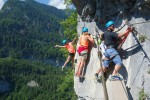
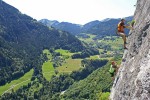
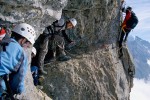
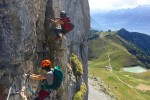
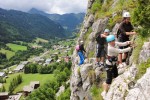
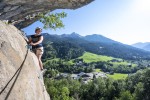
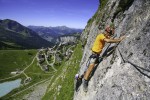
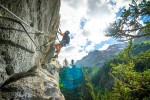
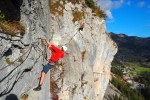
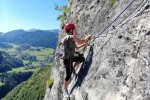
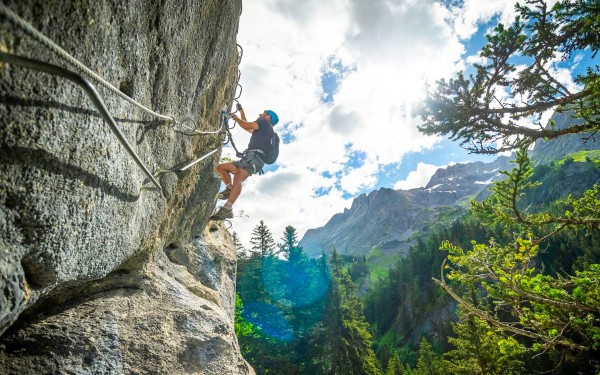
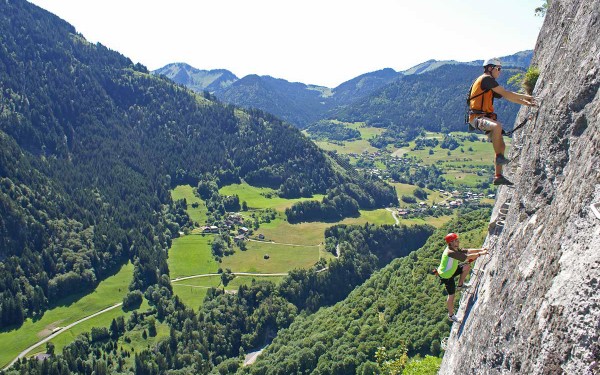
The term "Via Ferrata" is used in the sporting world of Mountaineering and means "iron road". It is a trail along a rock face that is plotted with steel cables. A Via Ferrata is called chemin câblé in France and Klettersteig in German.
Climbing in the French Alps
The Alps are a popular region where many like to spend their holidays. The mountains welcome you to take long walks. Nowadays, climbing is gaining more and more popularity. Many hikers are looking for a new challenge which they can find in the sport of climbing. The sport of climbing more of a challenge and can get you to places where hikers can not go.
The history of Via Ferratas starts in the Italian Dolomites, during the First World War. In those days fighting mainly takes place in the mountains. To move soldiers and weapons safely, steel cables were fastened to the mountain walls. Many years later these routes were used by tourists to get to places that were previously unreachable.
A Via Ferrata is a climbing course that is secured with steel cables. Everyone must secure themselves to the steel cable with a climbing set so that you’ll stay attached to the cable in the event of a fall. In a Via Ferrata, tools such as iron stairs, pins, brackets, and suspension bridges have been installed so that you can go from one mountainside to another by passing over a gorge.
Via Ferrata in Haute-Savoie
In Haute-Savoie there are several possibilities for climbing:
- Saix de Miolène (La Chapelle d'Abondance); This course, 5km from FranceComfort –AlpChalets Portes du Soleil, runs along a steep rock face and goes along beautiful rocks, has a succession of bends, multiple wedge-shaped transitions, and exciting overhanging sections. The route consists of three parts which are each named: goat, gems, and ibex. These sections can be crossed separately or sequentially. For the second and third part, the climber needs a decent amount of experience, or the trek can be carried out under supervision.
- Cliff of Foron (Côte d'Arbroz - Morzine); This rock face is characterized by the large number of holes in the cliff and the overhanging rocks. There are about 40 routes ranging between a height of 10m and 30m.
- Rocher de la Chaux (St. Jean d'Aulps); There are 2 Via Ferratas in de Rocher de la Chaux: the Tête de l'éléphant and the Oeil de l'éléphant. These differ in difficulty.
Both Via Ferratas provide a magnificent view over the valley.
Risks of mountaineering in the Alps
Climbing along a Via Ferrata involves risks. You should assess the risks and take them into account when preparing yourself. Some risks include:
- The weather: In the mountains, the weather can change very quickly. You could be enjoying sun in the morning and then be caught in the rain or a thunderstorm in the afternoon. Steel cables can attract lightning and when the lighting strikes a cable it could be life-threatening. So be sure to study the weather forecast well!
- Falling stones: A Via Ferrata path often goes up the mountain in a zig-zag pattern meaning there could be climbers at a higher level than you. These climbers can cause stones to fall, therefore it is mandatory to wear a helmet. And if stones do happen to fall, be sure to not look up and stay as close as possible to the rock face.
- Overestimation of a route: study the difficulty of the route in and do not take any unnecessary risks.
Difficulty of a Via Ferrata
The level of difficulty is determined by several factors:
- The duration of the route: Via Ferratas range in length from one-hour routes to all-day routes
- How to get to the start of the route: Some routes start near a village centre or can be easily reached by cable car. In other cases, a walk of one or more hours must be completed prior to starting the Via Ferrata.
- The nature of the Via Ferrata: The Via Ferrata can be a glorified hiking trail with steel cables in a few places or a trail along a perpendicular rock wall with overhanging sections where arm strength and climbing technique is needed. The nature is represented on a scale from simple to extremely difficult.
Unwind after a day of activities
After a day of climbing in the Alps, you can relax in one of FranceComfort – AlpChalets Portes du Soleils luxury apartments. Relax your muscles in the pool, sauna, or hot tub, then enjoy a glass of wine together with your loved ones in the comfortable living room before dining.











